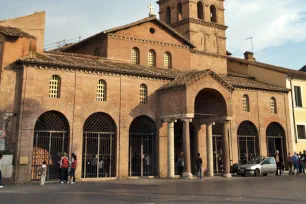The Mouth of Truth (Bocca della Verità in Italian) is an ancient Roman marble disc with a relief carving of a man’s face. According to legend, the face’s mouth closes if a liar sticks his hand in it.

The massive marble mask weighs about 1300 kg and probably depicts the face of the sea god Oceanus. The eyes, nostrils and mouth are open.
Origin
Historians aren’t quite certain what the original purpose of the disc was. It was possibly used as a drain cover in the nearby Temple of Hercules Invictus, which had an oculus – a round open space in the middle of the roof, similar to that of the Pantheon, hence it could rain inside. It is also thought that cattle merchants used it to drain the blood of cattle sacrificed to the god Hercules.
In the thirteenth century, the disc was probably removed from the temple and placed against the wall of the Santa Maria in Cosmedin. In the seventeenth century, it eventually moved to its current location inside the portico of the church.
The Legend of the Mouth of Truth

The marble disc is now famous for the medieval legend that is associated with it. People believed that the mouth of the marble face would close if anyone put his hand in it and told a lie. Therefore, it was used as some sort of lie detector.
Those who were accused of committing perjury or adultery were brought here. They had to swear under oath and then put their hand into the mouth. According to the legend, it was even used during the Middle Ages as a trial by ordeal. An executioner would hide behind the disc with a sharp sword ready to strike.
The legend became a popular part of culture, and even today parents threaten fibbing children with a visit to the Mouth of Truth. In the nineteenth century, the Italian writer Gioacchino Belli wrote a poem about the legend and the Mouth of Truth even entered American culture when it featured in the 1953 movie ‘Roman Holiday’.
Location

The Mouth of Truth stands against the left wall of the portico of the Santa Maria in Cosmedin church, at the piazza della Bocca della Verità, the site of the ancient Forum Boarium (the ancient cattle market). It attracts plenty of visitors who audaciously stick their hand in the mouth.
The church itself is definitely worth a visit as well. It is decorated with magnificent medieval mosaic tiles created by the Cosmati family. The church also incorporates ancient columns from Roman temples that once stood at this site.
- Next: Villa Farnesina
- More Rome Ancient Sights
- More Sights & Attractions in Rome

